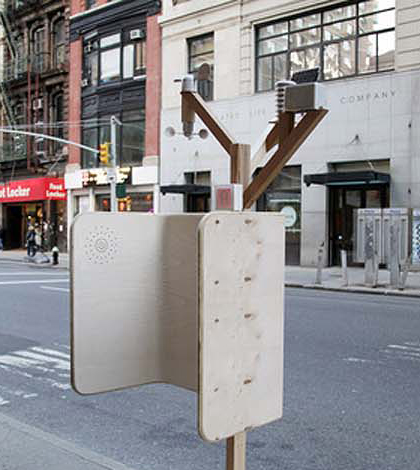Design reimagines NYC pay phones as environmental sensor stations

Though wind chimes are mostly used for decoration, they’re also a tool that communicates information about the environment. Their clanging tones let people know that the wind is blowing.
That’s why the simple garden ornament lends its name to a plan for redesigning New York City’s system of pay phones into a distributed, high-resolution real-time environmental sensing network.
“We’re collecting information about the environment and then we’re communicating it through the musical touch tones of the pay phone,” said Nick Wong, a member of the Windchimes design team and a mechanical engineering master’s student at Cooper Union.
The project came about as a response to New York City’s Reinvent Payphones Design Challenge. The challenge called for designers and engineers to submit working prototypes to bring the city’s 11,000 pay phones into the 21st century. Among more than 125 enentries, the Windchimes design placed first in the Community Impact category.
The platform has an adaptable design that allows for a custom set of sensors that best fit a particular pay phone’s location in the city. The most likely sensor options include those installed on the working prototype: weather (rainfall, temperature, humidity), wind (speed and direction), air particulate and noise levels.
The design retains the call-making functionality of the pay phone and depends on the phone line to transmit data to the Internet.
“We designed a protocol and communications systems that allows you to just plug in one of these environmental sensor units–one of these Windchimes–into any landline or phone line, and it connects to the Internet right away,” Wong said.
The information from the network could help environmental science applications like gathering microclimate data for a nearby green roof project or rainfall data for runoff mitigation efforts.
But the data could also prove useful well beyond the scientific community. It could even just help people get to work on time.
“We also thought about things like a bike riding algorithm that will take wind speed and direction data and customize your route so the wind is always at your back,” Wong said.
After their strong showing in the design contest, the city is providing channels for the team to present the idea. They’ll be demonstrating the prototype in some public venues soon. They’re also planning small pilot programs to see how the community reacts.
The Windchimes team also includes Cooper Union students Paul Miller, Eric Leong and Louis Lim (graduated); New York University Interactive Telecommunications Program student Ann Chen; and Parsons student Rena Lee.




0 comments